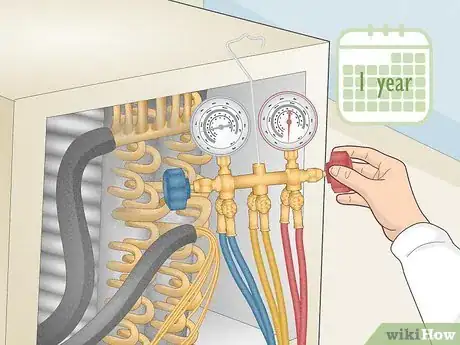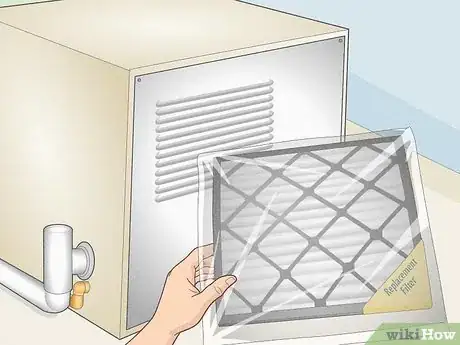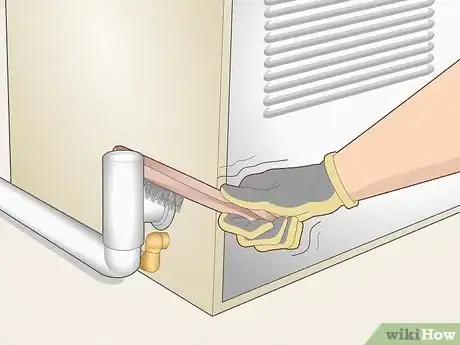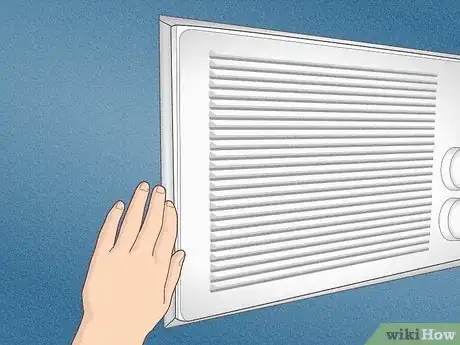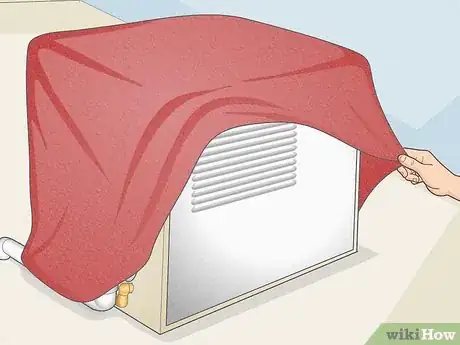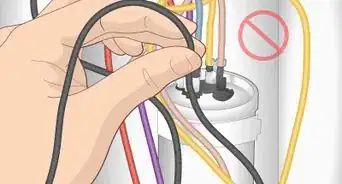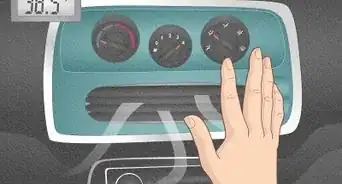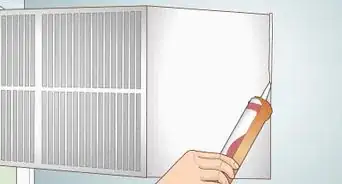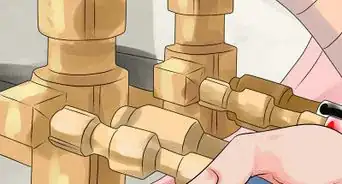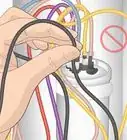This article was co-authored by Victor Belavus. Victor Belavus is an Air Conditioning Specialist and the Owner of 212 HVAC, an air condition repair and installation company based in Brooklyn, New York. In addition to HVAC and air conditioning units, Victor also specializes in furnace repair and air duct cleaning. He has over 10 years of experience working with HVAC systems.
This article has been viewed 136,739 times.
There are a few simple things homeowners can do to maintain their central or window-mounted air conditioners. These things keep your AC unit in good working order and can help reduce your energy use. For more technical maintenance, you should always hire an HVAC company because there are certain components that require professional knowledge and experience to maintain. We’ve put together this handy Q and A article to help you out with your DIY AC maintenance.
Steps
How do you change an AC filter?
-
1Remove the dirty air filter from the air conditioner. Locate the grill covering the AC filter and take it off by unscrewing it, if it’s held in place by screws, or by prying it off if you don’t see any screws. Simply pull out the filter by hand to remove it.[3]
- In central AC units, the filters are usually located somewhere along the length of the return duct behind a grill in the wall or ceiling.
- In window-mounted AC units, the filters are behind the grill that faces into the room.
-
2Wash the filter if it is reusable. Soak the filter in warm, soapy water to loosen dust and debris. Rinse off all the grime and let the filter air dry completely before you put it back in the air conditioner.[4]
- If you have a ductless split AC unit, you can just wipe off the filter behind the panel with a damp rag.
-
3Replace the filter if it is single-use. Purchase a replacement filter and throw out the dirty one. Just slide the new filter into the air conditioner the same way you removed the old one.[5]
- Replacement filters only cost about $10 USD or so.
- There are usually arrows on the filter showing you which way to orient it when you put it in your air conditioner.
How do you clean air conditioner coils?
-
1Inspect the coils for dirt and debris. Remove the access panel on the condenser unit to access the coils, which are the copper tubes that you see inside. Look for things like cobwebs, leaves, dirt, and other debris stuck to the coils.[6]
- On central AC units, the access panel for the coils is on one side of the outdoor condenser unit.
- For window-mounted AC units, the coils are located behind a panel on the back of the unit that faces outside.
- You only have to do this once a year to keep your AC unit’s coils clean. A good time to do so would be at the beginning of the summer if you live in a seasonal zone.
- AC coils are the parts of the system where the refrigerant absorbs heat.
-
2Remove large debris by hand and dust off the coils with a soft-bristled brush. Pull off things like leaves and chunks of dirt and discard them. Lightly dust off the coils with the brush, going in the same direction as the fins on the coils, to remove loose debris and things like cobwebs. Replace the access panel when you’re done cleaning and you’re all set![7]
- You can buy a special brush called a coil brush to do this, or just use any kind of whisk brush with soft nylon bristles. They’re pretty much the same thing.
- Note that this applies to any type of air conditioner.
-
3Clear the area around the condenser unit to help keep the coils clean. Trim any nearby foliage back to at least 2 ft (0.61 m) away to keep leaves and foliage out of the coils and allow for good airflow. Remove any other loose yard debris or dirt from the area around the condenser that could get sucked into the coils.[8]
- If your condenser unit is located in your yard, avoid passing a lawnmower right by the unit because it could shoot grass and other debris into it. You can use a pair of garden shears to keep grass right by the unit trimmed.
- This applies to central AC system condenser units, since window-mounted air conditioners aren’t on the ground.
- Condenser units are the outdoor part of the HVAC system that release or collect heat.
What other maintenance should I do to my AC unit?
-
1Straighten bent coil fins with a fin comb. When you clean your AC unit’s coils, look at the aluminum fins to see if they are bent. The fins are thin metal strips that run parallel to one another right next to the copper coils. If any of the fins look bent, brush a fin comb along their length to easily bend the fins back into their proper positions.[9]
- You can get a fin comb from AC wholesalers or online.
- If the coil fins are bent, they can block airflow through the coils and hurt performance.
- This applies to both central and window-mounted AC units.
-
2Pass a stiff wire brush through condensate drain lines occasionally. Locate the T-shaped condensate line coming off of the condenser unit. Push a skinny, stiff-bristled wire brush down into the top of the drain line and move it back and forth to loosen any clogs.[10]
- Note that this only applies to central AC units. Window-mounted units don’t have condensate drain lines.
- Condensate drain lines let all the moisture that gathers in the system drain out. They are usually white pipes that run out of the outdoor condenser unit.
Is there anything special I should do for a window AC unit?
-
1Inspect the seal between the AC unit and the window. Do this at the beginning of each cooling season because the seal can get damaged over time. Make sure the seal is making full contact with the AC unit’s housing and fix or replace it if it’s not.[11]
- One way to seal gaps around a window-mounted AC unit is by sticking adhesive-backed weather stripping around the unit.
- You can also fill small gaps by pressing rope caulk into them. Rope caulk is a clay-like material, so just mold it to fit into the cracks.
- If the seal is not good, cool air from the AC unit can escape your home through the crack.
-
2Wash the fans with soapy water. Remove the unit from the window, take it outside, and unscrew the housing. Locate the 2 fans: the blower fan near the evaporator and the bladed fan near the condenser. Scrub the fans with a soft brush and a solution of warm water and a few drops of dish detergent. Rinse off the fans with a hose and put your AC unit back together.[12]
- This is also a good time to rinse any water out of the condensate pan beneath the coils with fresh water from your hose.
How do I prepare my AC unit for winter?
-
1Store window-mounted AC units until the next cooling season. Take your AC unit out of the window and put it inside somewhere in a dry place. Put a cover over it to keep dust and dirt out.[13]
- This helps your window-mounted AC unit last much longer than if you let it weather the winter in your window sill.
-
2Cover the outdoor condenser unit for central AC systems. Purchase a condenser unit cover to fit your unit. Place it over the condenser at the end of cooling season to protect it from ice, snow, dirt, and debris through the winter months.[14]
- Outdoor condenser units are pretty durable and meant to hold up to cold weather, but excessive snow and ice can still damage the coils over time.
- Avoid hard plastic covers or any type of covers that completely restrict airflow because they can trap excessive moisture inside the unit, leading to internal damage.
Expert Q&A
Did you know you can get expert answers for this article?
Unlock expert answers by supporting wikiHow
-
QuestionHow do I clear my AC drain line?
 Victor BelavusVictor Belavus is an Air Conditioning Specialist and the Owner of 212 HVAC, an air condition repair and installation company based in Brooklyn, New York. In addition to HVAC and air conditioning units, Victor also specializes in furnace repair and air duct cleaning. He has over 10 years of experience working with HVAC systems.
Victor BelavusVictor Belavus is an Air Conditioning Specialist and the Owner of 212 HVAC, an air condition repair and installation company based in Brooklyn, New York. In addition to HVAC and air conditioning units, Victor also specializes in furnace repair and air duct cleaning. He has over 10 years of experience working with HVAC systems.
Air Conditioning Specialist
-
QuestionWhy is my AC not draining water?
 Victor BelavusVictor Belavus is an Air Conditioning Specialist and the Owner of 212 HVAC, an air condition repair and installation company based in Brooklyn, New York. In addition to HVAC and air conditioning units, Victor also specializes in furnace repair and air duct cleaning. He has over 10 years of experience working with HVAC systems.
Victor BelavusVictor Belavus is an Air Conditioning Specialist and the Owner of 212 HVAC, an air condition repair and installation company based in Brooklyn, New York. In addition to HVAC and air conditioning units, Victor also specializes in furnace repair and air duct cleaning. He has over 10 years of experience working with HVAC systems.
Air Conditioning Specialist
-
QuestionHow do you clean a clogged condenser coil?
 Victor BelavusVictor Belavus is an Air Conditioning Specialist and the Owner of 212 HVAC, an air condition repair and installation company based in Brooklyn, New York. In addition to HVAC and air conditioning units, Victor also specializes in furnace repair and air duct cleaning. He has over 10 years of experience working with HVAC systems.
Victor BelavusVictor Belavus is an Air Conditioning Specialist and the Owner of 212 HVAC, an air condition repair and installation company based in Brooklyn, New York. In addition to HVAC and air conditioning units, Victor also specializes in furnace repair and air duct cleaning. He has over 10 years of experience working with HVAC systems.
Air Conditioning Specialist If your condenser coil is clogged, turn off the power to the condenser from the disconnect switch and the electrical panel. Remove the protective grills from the sides of the condenser unit and clean it with a garden hose. You can also use condenser cleaning acid, but don't forget to use protective gear like gloves and goggles, and dilute the acid with water according to the manufacturer's instructions.
If your condenser coil is clogged, turn off the power to the condenser from the disconnect switch and the electrical panel. Remove the protective grills from the sides of the condenser unit and clean it with a garden hose. You can also use condenser cleaning acid, but don't forget to use protective gear like gloves and goggles, and dilute the acid with water according to the manufacturer's instructions.
References
- ↑ https://time.com/4408512/air-conditioning-mistakes/
- ↑ https://www.energystar.gov/campaign/heating_cooling/maintenance_checklist
- ↑ https://www.bobvila.com/slideshow/11-air-conditioning-mistakes-that-spike-your-bills-51293
- ↑ https://www.thisoldhouse.com/heating-cooling/21015171/5-essential-steps-for-window-ac-upkeep
- ↑ https://www.energy.gov/energysaver/maintaining-your-air-conditioner
- ↑ https://www.bobvila.com/articles/how-to-clean-ac-coils/
- ↑ https://www.bobvila.com/articles/how-to-clean-ac-coils/
- ↑ https://www.energy.gov/energysaver/maintaining-your-air-conditioner
- ↑ https://www.energy.gov/energysaver/maintaining-your-air-conditioner
- ↑ https://www.energy.gov/energysaver/maintaining-your-air-conditioner
- ↑ https://www.energy.gov/energysaver/maintaining-your-air-conditioner
- ↑ https://www.thisoldhouse.com/heating-cooling/21015171/5-essential-steps-for-window-ac-upkeep
- ↑ https://www.thisoldhouse.com/heating-cooling/21015171/5-essential-steps-for-window-ac-upkeep
- ↑ https://www.energy.gov/energysaver/maintaining-your-air-conditioner
